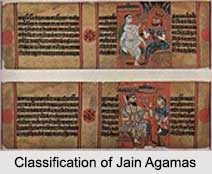 Jain Agamas are canonical texts of Jainism based on the teachings of Lord Mahavira. Mahavira"s preaching that were orally compiled by his disciples into various Sutras. There are 45 Jain Agamas which are regarded as the most ancient and authoritative works.
Jain Agamas are canonical texts of Jainism based on the teachings of Lord Mahavira. Mahavira"s preaching that were orally compiled by his disciples into various Sutras. There are 45 Jain Agamas which are regarded as the most ancient and authoritative works.
According to the Swetambara Sect, there are 45 scripture; which are classified in two sections, namely; Anga Pravista and Anga Bahya. These sections are again sub-divided into 12 Angas, 12 Upangas, 10 Prakiranakas, 6 Cheda Sutras, 4 Mula Sutras and 2 Culika Sutras. The Digambara sect believes that there were 25 Agamas.
Swetambara Canonical Literature
The classifications of Jain Agamas according to the Swetambara Sects are as follows:
Anga Pravista
These texts are the core Canons. They give detailed information on Jain Philosophy, Religion and History. It is generally believed that whatever knowledge Lord Mahavira delivered to his disciples after attaining omniscience was compiled by the Gandharas. They are the oldest and original part of the canonical literature.
Anga Bahya
These texts are supplementary to the Anga Pravista texts, written by Sthaviras (elder monk) and Acharyas (Heads of the monastic order). They are further sub-divided:
•Upangas - These scriptures provide further explanation of Angas. The Upangas were composed by different Acharyas.
•Prakirnakas - It is a collection of ten texts giving information on human body, food, living conditions and death.
•Cheda Sutras - These sutras are focused on the rules of confession and repentance for violating any monastic rules.
•Mula Sutras -These sutras are very important as they are the foundation sutras for the beginners of the spiritual career. They have to be mastered before entering into the monastic life.
•Culika Sutras - These are very important, as they provide additional information not mentioned in the Anga sutras.
Digambara Canonical Literature
The Digambar sect believes that there were 25 Agama Sutras complied from the original preaching of Lord Mahavira. However, they were gradually lost starting about 200 years after Lord Mahavira"s Nirvana. Hence, the existing Agama Sutras which are accepted by the Swetambara sects are not accepted by them as authentic scriptures.
In the absence of authentic scriptures, Digambaras consider the "Satakhandagama" and "Kashaya Prabhruta" as the Agama substitute texts. These scriptures were written by great Acharyas from 100 to 800 CE and are based on the original Agama sutras.



















